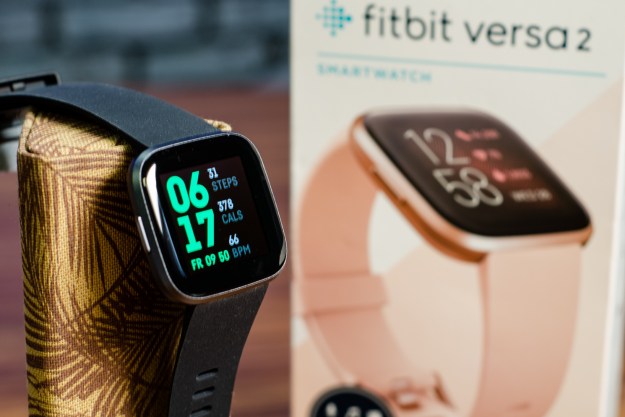It’s one giant step past step-counting.
With new key new features such as continuous heart-rate monitoring and touch screens, as well as an improvement to the already slick design, Fibtbit’s latest trackers offer lots of new features for fitness fans. The Flex — launched in May of 2013 — was the company’s first foray into a true fitness band, but Fitbit has been notably silent after complaints of rashes led to the withdrawal of the more advanced Force from the market. The company is ready at last to add to its lineup, with three new devices: the Surge, Charge HR, and Charge sans heart rate monitor.
The first two wearables won’t hit store shelves until 2015, but the third is available now. All three are fitness focused and continue along the same stylistic path as the Fitbit Flex, but with a few huge improvements.
Fitbit Charge comes with an optional heart-rate monitor
Just like most other fitness trackers, the Fitbit Charge tracks the number of steps you’ve taken, distance traveled, calories burned, and any flights of stairs you might have climbed throughout the day. And users can keep tabs on their progress using the app’s dashboard or see real-time exercise stats to get a better idea of how well a workout is going. But the Charge doesn’t just give you run-of-the-mill fitness data, it also features automatic sleep detection, which enables the band to analyze sleep quality and understand your natural sleep and wake times. You can set an alarm in the app on your phone and the Charge will vibrate to wake you up gently.
The Charge sports a small OLED screen that displays the time, stats, caller ID for incoming calls, and other key info. The fitness band will even vibrate when you get a call, so you know to drag your phone out of your bag. Luckily, the addition of a screen doesn’t hurt its battery life — Fitbit told us the Charge lasts up to an entire week. The band itself is water-resistant and slightly textured. Fitbit told us that the band can survive a shower, but the company doesn’t recommend swimming with it.
The Charge has the same kind of buckle-like clasp found on most watch bands, so it should be more secure and easy to fasten than the Flex. It’s remarkably light and the strap is about an inch wide. The Charge is available now in black, slate, blue, and burgundy for $130.
Fitbit will also offer a version of the Charge that has a built-in heart-rate monitor for 24/7 tracking. This version of Charge uses Fitbit’s own PurePulse technology, which detects changes in your blood volume as your heart pumps using safe LED lights. The company says that the addition of a heart-rate monitor allows the app to better determine calorie burn, maximize training, and ensure that your workout reaches the desired level of intensity.The battery life does take a slight hit and lasts only five days on a single charge, but that’s still longer than most smartwatches.
The heart-rate monitor also adds a bit of bulk to the fitness band, so it sticks off of your wrist more than the standard version. The Charge with heart monitor included will cost $150 when it debuts in 2015. Would-be buyers will be able to choose from tangerine, plum, black, and blue.
Fitbit Surge is a smart fitness watch with a heart rate monitor
One of the most common complaints with fitness bands is the lack of a screen — the Fitbit Flex was no exception. Luckily, Fitbit has been listening and the Surge is its answer. The FitBit Surge is a smartwatch with a built-in heart-rate monitor and a focus on fitness metrics. It has a backlit LCD touchscreen in black and white. You can even change the watch face, if you want. The watch has all the same features as the Charge but also offers many unique perks.
The Surge sports eight sensors, including three-axis accelerometers, gyroscope, compass, ambient light sensor, GPS, and a heart-rate monitor. Even though it has a bigger screen, Fitbit says the battery should last up to 7 days or through an entire marathon. It’s also water resistant like the Charge, but you still probably shouldn’t swim with it. The strap looks to be about 2 inches wide and has the same watch-style clasp for a secure fit. The screen adds extra bulk, as does the heart-rate monitor, so it may feel large on small wrists, but it looks quite comfy on larger ones. However, Fitbit does say it will offer different sizes so the ladies don’t get left out.
Thanks to built-in GPS, the Surge can track your pace, distance, elevation, split times, and route history, while generating a workout summary for you to check out later. You can even view your metrics on the watch itself during the workout if you’re worried that you’re not keeping your heart rate up. All the data is available in the companion app, too, of course, but it’s nice to see results in real time.
In addition to tracking fitness metrics, the Surge also acts like a true smartwatch. So as not to overwhelm users and keep the watch fitness-focused, Fitbit chose to add just the most basic smartwatch features, including caller ID, text alerts, and mobile music controls. Fitbit reasons that when you’re working out, you might be waiting for an important call or text, but you certainly won’t care if someone likes your picture on Facebook.
The Fitbit Surge will cost $250 when it debuts in 2015 and will be available in black, blue, and tangerine.
Editors' Recommendations
- Are smartwatches and fitness trackers making us more anxious?
- How to reset the Fitbit Charge 3: Restarts and resets
- Fitbit Charge 5 leaks show off a sleek fitness wearable
- The Fitbit Luxe helps you manage your stress levels — and look good doing so
- Fitbit Versa 3 vs. Fitbit Versa 2


